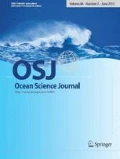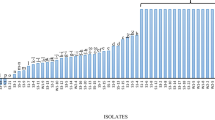Abstract
Heavy metal pollution is an environmental issue globally and the aim of this study was to isolate endophytic fungi from mangrove wetlands of Sarawak to assess and test their ability to grow in the presence of various heavy metals (copper (Cu), zinc (Zn), lead (Pb), and chromium (Cr)). Samples of Nypa fruticans were collected from Kuching Wetland National Park (KWNP) for subsequent endophyte isolation. Ninety-three (93) isolates were obtained and assessed and the most resistant isolates (growing at concentrations up to 1000 ppm) were identified using fungal primers ITS 1 and ITS 4. All of the endophytic fungi were identified to be closely related to Pestalotiopsis sp. and this is to our knowledge the first study reporting the ability of Pestalotiopsis sp. to grow at high concentrations of copper, lead, zinc and chromium. Our results highlight the potential of using endophytic fungi for the treatment of heavy metal pollution, for example as biosorbents.
Similar content being viewed by others
References
Alloway BJ (1995) Heavy metals in soils. 2nd edn. Blackie Academic & Professional, London, 322 p
APHA (1999) Standard Method for the Examination of Water and Wastewater. American Public Health Association, American Water Works Association, Water Environment Federation, 541 p
Arica MY, Kacar Y, Genc O (2001) Entrapment of white-rot fungus Trametes versicolor in Ca-alginate beads: preparation and biosorption kinetic analysis for cadmium removal from an aqueous solution. Bioresource Tech 80:121–129
Bayramoglu G, Denizli A, Bektas S, Arica MY (2002) Entrapment of Lentinus sajorcaju into Ca-alginate gel beads for removal of Cd(II) ions from aqueous solution: preparation and biosorption kinetics analysis. Microchem J 72:63–76
Congeevaram S, Dhanarani S, Park J, Dexilin M, Thamaraiselvi K (2007) Biosorption of chromium and nickel by heavy metalresistant fungal and bacterial isolates. J Hazard Mater 146:270–277
Cruz CC, da Costa AC, Henriques CA, Luna AS (2004) Kinetic modeling and equilibrium studies during cadmiumbiosorption by dead Sargassum sp. biomass. Bioresource Tech 91(91): 249–257
Davis TA, Volesky B, Mucci A (2003) A review of the biochemistry of heavy metal biosorption by brown algae. Water Res 37(37): 4311–4330
Deng Z, Zhang R, Shi Y, Tan H, Cao L (2014) Characterization of Cd-, Pb-, Zn-resistant endophytic Lasiodiplodia sp. MXSF31 from metal accumulating Portulaca oleracea and its potential in promoting the growth of rape in metal-contaminated soils. Environ Sci Pollut Res 21(21):2346–2357
El-Gendy MMA, Hassanein NM, Ibrahim HAE, El-Baky DHA (2011) Evaluation of some fungal endophytes of plant potentiality as low-cost adsorbents for heavy metals uptake from aqueous solution. Aust J Basic Appl Sci 5(5):466–473
Ezzouhri L, Castro E, Moya M, Espinola F, Lairini K (2009) Heavy metal tolerance of filamentous fungi isolated from polluted sites in Tangier, Morocco. Afr J Microbiol Res 3(3):35–48
Fan T, Liu Y, Feng B, Zeng G, Yang C, Zhou M, Zhou H, Tan Z, Wang X (2008) Biosorption of cadmium(II), zinc(II) and lead(II) by Penicillium simplicissimum: Isotherms, kinetics and thermodynamics. J Hazard Mater 160:655–661
Faryal R, Sultan A, Tahir F, Ahmed S, Hameed A (2007) Biosorption of lead by indigenous fungi. Pak J Bot 39(39):615–622
Guba EF (1929) Monograph of the genus Pestalotia de Notaris. Part1. Phytopathology 19:191–232
Guo B, Wang Y, Sun X, Tang K (2008) Bioactive natural products from endophytes: a review. Appl Biochem Microbiol 44:153–158
Gupta R, Ahuja P, Khan S, Saxena R, Mohapatra H (2000) Microbial biosorbents: meeting challenges of heavy metal pollution in aqueous solutions. Curr Sci 78(78):967–973
Hach (2005) Procedures Manual DR 2800 Spectrophotometer. 1st edn. Hach Company, USA
Hemambika B, Johncy RM, Kannan VR (2011) Biosorption of heavy metals by immobilized and deadfungal cells: a comparative assessment. J Ecol Nat Environ 3(3):168–175
Hong JW, Park JY, Gadd GM (2010) Pyrene degradation and copper and zinc uptake by Fusariumsolani and Hypocrealixii isolated from petrol station soil. J Appl Microbiol 108(108):2030–2040
Iram S, Zaman A, Iqbal Z, Shabbir R (2013) Heavy metal tolerance of fungus isolated from soil contaminated with sewage and industrial wastewater. Polish J Environ Stud 22(22):691–697
Iskandar NL, Zainudin NAIM, Tan SG (2011) Tolerance and biosorption of copper (Cu) and lead (Pb) by filamentous fungi isolated from a freshwater ecosystem. J Environ Sci 23(23):824–830
Jeewon R, Liew CY, Simpson JA, Hodgkiss IJ, Hyde KD (2003) Phylogenetic significance of morphological characters in the taxonomy of Pestalotiopsis species. Mol Phylogenet Evol 27:372–383
Kadirvelu K, Senthilkumar P, Thamaraiselvi K, Subburam V (2002) Activated carbon prepared from biomass as adsorbent: rlimination of Ni(II) from aqueous solution. Bioresource Tech 81:87–90
Kapoor A, Viraraghavan T, Cullimore DR (1999) Removal of heavy metals using the fungus Aspergillusniger. Bioresource Tech 70:95–104
Kjer J, Debbab A, Aly AH, Proksch P (2010) Methods for isolation of marine-derived endophytic fungi and their bioactive secondary products. Nature Protoc 5(5):479–490
Li YH, Zhu JN, Zhai ZH, Zhang Q (2010) Endophytic bacterial diversity in roots of Phragmitesaustralis in constructed Beijing Cuihu Wetland (China). FEMS Microbiol Lett 309:84–93
Luo JM, Xiao X, Luo SL (2010) Biosorption of cadmium (II) from aqueous solutions byindustrial fungus Rhizopuscohnii. T Nonferr Metal Soc 20:1104–1111
Maharachchikumbura SN, Guo L-D, Ekachai C, Ali HB, Hyde KD (2011) Pestalotiopsis-morphology, phylogeny, biochemistry and diversity. Fungal Divers 50:167–187
Manoharachary C, Sridhar K, Singh R, Adholeya A, Suryanarayanan TS, Rawat S, Johri BN (2005) Fungal biodiversity: distribution, conservation and prospecting of fungi from India. Curr Sci 89:58–71
Nazli MF, Hashim NR (2010) Heavy metal concentrations in an important mangrove species, Sonneratiacaseolaris, in Peninsular Malaysia. Environ Asia 3(3):50–55
Nriagu JO (1980) Global cadmium cycle. In: Nriagu JO (ed) Cadmium in the Environment. Part I: Ecological Cycling. Wiley, New York, pp 1–12
Nriagu JO, Pacyna JM (1988) Quantitative assessment of worldwide contamination of air, water and soils by trace metals. Nature 333:134–139
Onn ML (2012) Screening of mangrove endophytic fungi for bioactive compounds. M.S. Thesis, Universiti Malaysia Sarawak
Ozdemir G, Ceyhan N, Ozturk T, Akirmak F, Cosar T (2004) Biosorption of chromium(VI), cadmium(II) and copper(II) by Pantoea sp. TEM18. Chem Eng J 102:249–253
Pacyna J (1986) Atmospheric trace elements from natural and anthropogenic sources: toxic metals in the atmosphere. Wiley, New York
Salvadori MR, Lepre LF, Ando RA, Nascimento CAO, Corrêa B (2013) Biosynthesis and Uptake of Copper Nanoparticles by Dead Biomass of Hypocrea lixii Isolated from the Metal Mine in the Brazilian Amazon Region. PloS ONE 8(8):e80519. doi:10.1371/journal.pone.0080519
Shazili NAM, Yunus K, Ahmad AS, Abdullah N, Rashid MKA (2006) Heavy metal pollution status in Malaysian aquatic environment. Aquat Ecosyst Health Manage 9(9):137–145
Steyaert RL (1949) Contribution à l'étudemonographique de Pestalotia de Not.et Monochaetia Sacco (Truncatella gen. nov. et Pestalotiopsis gen. nov.). Bull Jardin Bot État Bruxelles 19:285–354
Strobel G, Yang X, Sears J, Kramer R, Sidhu RS, Hess WM (1996) Taxol from Pestalotiopsismicrospora, an endophytic fungus of Taxuswallachiana. Microbiology 142(142):435–440
Tamura K, Peterson D, Peterson N, Stecher G, Nei M, Kumar S (2011) MEGA 5: molecular evolutionary genetics analysis using maximum likelihood, evolutionary distance, and maximum parsimony methods. Mol Biol Evol 28(28):2731–2739
Valix M, Tang J, Malik R (2001) Heavy metal tolerance of fungi. Mine Eng 14(14):499–505
Volesky B, Holan ZR (1995) Biosorption of heavy metals. Biotechnol Prog 11:235–250
Wang J, Chen C (2009) Biosorbents forheavy metals removal and their future. Biotechnol Adv 27(27):195–226
Wiyakrutta S, Sriubolmas N, Panphut W, Thongon N, Danwisetkanjana K, Ruangrungsi N, Meevootisom V (2004) Endophytic fungi with anti-microbial, anti-cancer and anti-malarial activities isolated from Thai medicinal plants. World J Microb Biot 20:265–272
Xu J, Kjer J, Sendker J, Wray V, Guan H, Edrada R, Lin W, Wu J, Proksch P (2009) Chromones from the endophytic fungus Pestalotiopsis sp. isolated from the Chinese mangrove plant Rhizophora mucronata. J Nat Prod 72(72):662–665
Yang HB, Tan N, Wu FJ, Liu HJ (2012) Biosorption of uranium (VI) by a mangrove endophytic fungus Fusarium sp. #ZZF51 from the South China Sea. J Radioanal Nucl Chem 292:1011–1016
Zhang Z, Schwartz S, Wagner L, Miller W (2000) A greedy algorithm for aligning DNA sequences. J Comput Biol 7:203–214
Zhang Y, Zhang S, Liu X, Wen H, Wang M (2010) A simple method of genomic DNA extraction suitable for analysis of bulk fungal strains. Lett Appl Microbiol 51(51):114–118
Author information
Authors and Affiliations
Corresponding author
Rights and permissions
About this article
Cite this article
Choo, J., Sabri, N.B.M., Tan, D. et al. Heavy metal resistant endophytic fungi isolated from Nypa fruticans in Kuching Wetland National Park. Ocean Sci. J. 50, 445–453 (2015). https://doi.org/10.1007/s12601-015-0040-2
Received:
Revised:
Accepted:
Published:
Issue Date:
DOI: https://doi.org/10.1007/s12601-015-0040-2




